|
SAI BABA
By Alejandro
Agostinelli
Translated from "Gatopardo"
Magazine
Feb 2002 No. 21 Yr XX - PP. 44-61 & 120-121
www.gatopardo.com
Divine sin |
|
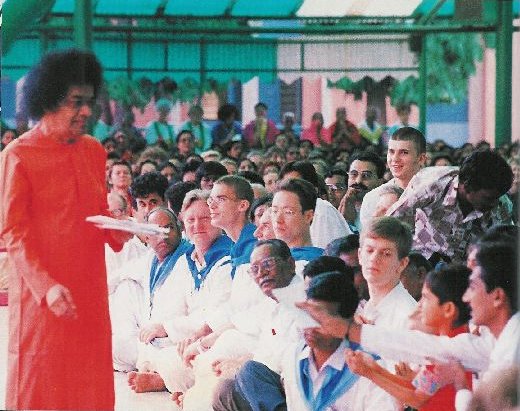 |
|
Sai Baba,
the well known Hindu spiritual teacher,
who has a following of
millions around the world,
is facing charges of sexual abuse. The
accusers asser that Baba has made many of his male
devotees engage in sexual practices with him.
Journalist Alejandro Agostinelli investigated the certainty of
these charges. |
I
have Monica Socolowicz, the woman who introduced the Sathya Sai Organization to
Argentina, in front of me. I am at her Foundation for Practical Spirituality.
Monica’s first visit to India was in 1979, when Sai Baba greeted her in a way
that made a deep impression on her: “You came at last!” he said to her. The
teacher asked her to start the first Sai Center in Argentina and so she did. For
a period of ten years she took more than 400 groups of Argentineans to
Puttaparthi, the village in the south of India where Baba’s ashram is located.
In 1992 she left the Organization because she didn’t agree with its “chauvinist
and vertical” structure. But she is proud of the spiritual relationship that she
still maintains with the avatar (divine incarnation).
Sri Sathya
Sai Baba is the most influential Eastern guru in the West. And Monica is the
founder of the first apostolic centre of the cult in Latin America. The main
high-ranking officers of the Sathya Sai Organization are Argentineans and in
this country alone Baba has over 100,000 followers. Monica is aware of the
arguments of the critics. She listens patiently. She hears, but makes no
judgment. “How can I judge something I can’t understand?” She says that her life
experienced a great evolutionary leap when Baba said to her: “I don’t exist, I
am the mirror in which you see yourself.”- “I don’t know if he is right. But
soon enough I realized that there are as many ways to tell this incredible story
as there are images that take place between two mirrors that face each other.”
Initially, it
wasn’t my intention to write this chronicle or do a program on television. I
wasn’t aware at the time that Sai Baba could interest the readers of
Gatopardo or even more, that Zona de Investigacion (Azul TV,
Argentina) was going to ask me to produce two programs that would be seen by
more than a million viewers. I started this investigation seeking the truth
about God. Or should I say, I began to verify certain allegations about a man
who says he is God. Why? Well, you would have to continue reading.
Even though
many affirmed the opposite, I wasn’t sure that Sai Baba sexually abused minors.
If it were not for the great influence that the guru has on Indian government
officials, judges, members of the diplomatic corps and public figures in
general, the mere existence of such charges would not have kept me up nights.
But eventually, it did keep me up. It all started when my friend Enrique
Marquez, an Argentinean illusionist who is an expert on paranormal frauds,
suggested that I visit the website Saiguru.net (http://www.saiguru.net/),
a quarry of unknown data pertaining to Sai Baba. The dissidents do not question
the message; but they are raging against the messenger, whom they describe as an
insatiable sexual plunderer. When I started surfing through the Web – I copied
nearly 150 files – the smile froze on my face.
“Could this
be the great neo-religious farce of the millennium? Sai Baba…a gay god?” This is
what I thought while I devoured the documents in a mixture of amazement,
morbidity and incredulity. Those pages, a cross between a complaint box and an
anti-new age Bible, were, in part, the Spanish version of an online
document entitled The Findings which was posted on the web at the
beginnings of the year 2000 by David and Faye Bailey: This contained accusations
that went from spiritual ruffianism to financial affront, charges of strategies
of psychological manipulation, and scandalous allegations of sexual abuse
concealed by a religious practice. The Baileys reveal how they began to snatch
off God’s mask. Faye Bailey relates how the blindfold fell off her eyes when she
concentrated her attention on Baba’s hands and was able to see how he was
pulling rings, watches and trinkets from behind the side cushions of his
armchair. But those apparent tricks, she says, were not the worst of it: “We
were still at the ashram when a young student begged of David: ‘Please sir, do
something to stop him molesting us sexually.’” Later on they heard stories from
other young men to whom David had given music lessons in the Sai colleges in
Puttaparthi.
I sent an
email to Saiguru.net. It was answered by Lionel Fernandez, a Cuban-American
designer residing in Mexico. He immediately gave me his phone number. Li was a
follower of Sai Baba for 25 years. His group had adopted and studied the guru’s
philosophy until July 2000 when he stumbled upon The Findings. Li wrote
to several devotees, friends of his, to find out if he could trust the Baileys,
and as he began to receive answers his faith began to crumble. “How am I going
to tell my people that what I’ve been preaching for the last 25 years is not
true?” he asked himself. My skepticism, however, was pragmatic: experience had
taught me that there are few complaints against a spiritual leader that could be
more destructive than accusing him of alleged sexual harassment or molestations.
It is difficult to prove, easy to install and almost impossible to erase.
Lionel passed on his contacts to me and we began discussions during the
entr’actes of the grand drama. I refused to expose the story without first
checking the reliability of the sources. The ring of the accusations was
persuasive. But no one believes, and no one should believe sources that are only
available through the Web.
One of the
“infidels” was Conny Larsson, a Swedish actor who – after 21 years of devotion –
admitted having sustained a sexual relationship with the guru between 1979 and
1983. In an Open Letter, Larsson demanded of Baba to “stop using the guise of
God to satisfy your own desires. ... The other devotees did not know what was
going on between you and me in the inner interview room. I did not know myself;
I just believed you when you said that you were God and were helping me with my
problems by taking care of my Kundalini-process. …You also did oral sex on me
several times; you always seemed to enjoy it immensely…” I wrote to him and we
talked. Larsson had been a very popular devotee. In 1978 Conny left his business
in Sri Lanka at Baba’s request and installed himself in the ashram to become
part of the inner circle sitting for years next to the guru’s throne. Baba named
him Spiritual Coordinator of the Sai Organization in Sweden and gave him
instructions to promote his (Baba’s) work throughout the world. Towards the end
of 1999, Conny’s belief was turned around completely. He talked to me with his
heart in one hand, a real thirst in the other – perhaps the anger of a rejected
lover. Meanwhile, I was asking myself: How is it possible that an adult could go
on believing even when the other was making him do things that he wouldn’t have
accepted under any other circumstances? ¿Could these accusations be based on a
misunderstanding of a certain spiritual practice, incomprehensible from a
Western Christian point of view?
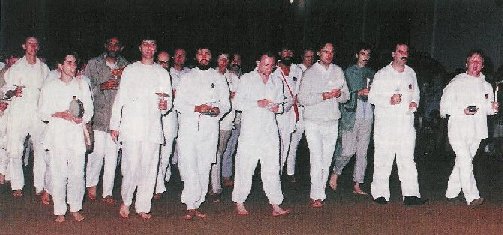 |
|
The Swedish actor Conny Larsson (extreme right)
celebrates with other devotees from his country. Although he was Sai Baba's
disciple for 21 years and one of the teacher's favorites, he now accuses
him of sexual harassment. |
A bit
of advice? For the time being, keep your critical spirit in suspense; and put
yourself in the place of no less than 10 million devotees. Drink in one gulp the
nectar of faith: Sai Baba, even if it is only because he has reached the age of
76 without the usual failings, deserves to be considered a god. “Don’t be
deceived by the presence of My body,” he said once. “All My actions are
selfless. There is no trace of selfishness in Me. If you have total faith,
wherever you are, all your wishes will come true without your asking.” His
appeals to have us immerse ourselves in his personal religion and the habit of
referring to himself as divine could be annoying. But remember that God’s nature
is enigmatic by definition. “Love My uncertainty,”
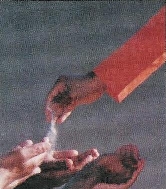 he says, “you can never
understand the Avatar.” He talks pretty, that Sai. Everything he says –
variations on the themes of love, truth and non-violence – seems to go well with
what one would expect from whom he claims to be. Besides, he materializes
brand-name watches, Tiffany jewels that have a serial number, and an abundant
amount of vibhuti – a kind of ash with reputed healing powers that seems to fall
from his fingers – to alleviate all illnesses from the multitudes of those
enamored of His Divine Presence. He can also raise the dying from their litters.
He makes invalids walk. He heals incurable diseases. From the devotees that have
nothing, he asks for nothing, except their unconditional love. One of his
faculties consists in convincing millionaire devotees to yield part of their
fortunes for acts of charity, like the upkeep of his temples in the south of
India (Puttaparthi in the state of Andhra Pradesh, and Whitefield in Karnataka),
the building of schools that teach his word or of free hospitals with the
avatar’s franchise and waterways to supply the thirstiest needy in that part of
India.
he says, “you can never
understand the Avatar.” He talks pretty, that Sai. Everything he says –
variations on the themes of love, truth and non-violence – seems to go well with
what one would expect from whom he claims to be. Besides, he materializes
brand-name watches, Tiffany jewels that have a serial number, and an abundant
amount of vibhuti – a kind of ash with reputed healing powers that seems to fall
from his fingers – to alleviate all illnesses from the multitudes of those
enamored of His Divine Presence. He can also raise the dying from their litters.
He makes invalids walk. He heals incurable diseases. From the devotees that have
nothing, he asks for nothing, except their unconditional love. One of his
faculties consists in convincing millionaire devotees to yield part of their
fortunes for acts of charity, like the upkeep of his temples in the south of
India (Puttaparthi in the state of Andhra Pradesh, and Whitefield in Karnataka),
the building of schools that teach his word or of free hospitals with the
avatar’s franchise and waterways to supply the thirstiest needy in that part of
India.
Baba says
that not only he but all, absolutely all of us are gods. The difference is that
he incarnated in the consciousness of his divinity and this lucidity allows him
to snatch from the air a gold locket with a portrait of himself or a wad of
dollar bills. The rest of us mortals, even though we end up as gods, cannot do
this. He knows he is God. That is why he can perform tasks that are impossible
for us to do, even if they weren’t punishable by law (try to explain to the IRS
that you can manifest your money from the air). Even though it is common
knowledge that he is supposedly aware of what happens to everybody at all times,
it seems as if the only thing he does in this life is to wait for the arrival of
the multitudes that will see him pass by at darshan, as the
fifteen-minute walk he performs twice a day is called. During this walk Sai Baba
will accept some letters, reject others, and materialize a few grams of ash,
rings or necklaces.(See photo at the beginning of article)
Sai
Baba was born on November 23, 1926 in Karnatakka-Nagepalle, a small village
across from Puttaparthi. His parents named him Sathyanarayana. When he was 14
years old, Sathya announced to his family that he was the reincarnation of Sai
Baba of Shirdi, an Indian holy man who died in 1918. This guru allegedly
predicted that he would be born again eight years later somewhere in south
India. In line with his predecessor, Sathya Sai Baba has foretold that he will
live until he is 96 years old – that is until 2022 – to reincarnate a year later
in a village in Karnataka state, with the name of Prema Sai.
Puttaparthi,
the village that has flourished due to Sai Baba’s fame, is host to millions of
pilgrims each year. Seventy-five Sai schools and three highly complex hospitals
are managed from this town. The ashram can accommodate ten thousand visitors,
though during holidays the multitudes outgrow the place. There is talk of
anywhere from ten to a hundred million devotees. Sai Baba is not a jealous God:
he doesn’t ask us to leave our religion, should we have one in particular, since
all roads lead to Him.
Now I am
going to suggest that you open your eyes and adopt the point of view of those
who reduce Baba to the stature of a sophisticated charlatan. The critics aim
first at the medulla of the power attributed to the holy man: the legitimacy of
his materializations. Far from materializing objects from nothing, they say he
materializes nothing. Professional magicians and disenchanted devotees who had
the opportunity of a close-up of these miracles subscribe to this idea. The
skeptics, for instance, present a video that shows how Baba changes a necklace
from his left hand (where he holds the envelopes of letters handed to him by the
devotees during darshan) to his right hand, with which he makes circles
in the air to “camouflage the trick” and later hands over the “manifested”
object. The disciplined devotee only shrugs when facing interrogations regarding
this. There are exceptions, however. Some years back I presented Alejandro
Sanchez – a Uruguayan friend who was then a believer in Sai Baba – the vibhuti
recipe according to skeptics: “One of the formulas would be a mixture of cow
dung and sandalwood; it is toasted and then made into little pellets and let
dry. Baba keeps them hidden and later on he pulverizes them in between his
fingers.” He listened to me in silence. Days later he told about a dream he had
had. He had always been impressed by a ritual in which Baba seems to bring forth
from an empty urn torrents of vibhuti, more than the urn could hold. He even
turns it upside down, the way magicians do to show that it is empty. In his
dream he imagined the urn with pressed ash pasted on the sides inside the urn
and he came to the conclusion that Baba was scraping the sides and bottom of the
urn. Upon awakening, he asked himself: “If he’s God, why does he need an urn?”
Alejandro had begun to have rationalist dreams. His faith was weak: he
immediately stopped believing in Super Baba. Other less presumptuous gods began
to be more believable to him.
More than
refuting illusions, the challenge lies in understanding the paradox involved in
the controversy. The same devotees who until a while back accepted Baba’s
miracles, now as surely believe the testimonies of those who declare they have
been sexually abused. And the other way around: the devotees who discard the
stories of those who assure us that they were forced to have sexual relations
with the guru, continue accepting a priori the stories of his equally unprovable
wonders.
The
indications of fraud do not seem to shake those souls that are firm in divine
indulgence. In her book Sai Baba el Señor (Sai Baba the Lord), the
devoted author Graciela Busto relates the case of a gentleman who saw how a
silver bracelet – that to the eyes of others, Baba had changed into gold – still
remained on his velvet-covered chair. “‘He didn’t transform it!’ said the
devotee to himself, and the scaffold of his face came tumbling down,” writes
Busto, who then asks: “Why does Baba become ‘careless’ or ‘give himself away’ in
such a manner in front of a devotee whom he had called to His side so many
times?” For Busto, there was an answer: “To provoke a radical change in him.”
What to some meant to have caught an impostor “red-handed,” for others was a
“proof of faith,” a blessed fraud to achieve a spiritual transformation in
sinners.
Hearing the
sexual confessions of the devotees leads to the need to prove if: a) the
ineffectiveness of the charge of fraud had created the need for a more
destructive accusation;or 2) these allegations answer to one of the
leitmotivs of the founder of the Puttaparthi empire: the inordinate sexual
appetite of a pedophile god.
So far there
is no legal judgment, but the principle of innocence does not impede
investigation. The judges of the High Court and the CIB in India yawn in the
face of legal complaints or international protests. On March 12, 2001 the Indian
engineer Hari Sampath presented to government authorities in India, as well as
in the United States, a 125-page document with sworn declarations by 30 people,
ten of which pertained to sexual abuse of American citizens (four of whom were
underage), and included supposed victims of dishonest abuse from different parts
of the world. Sampath is 35 years old and is the strongest activist of the
deserters. He was a former officer in the security force in Baba’s ashram from
1992 to1995 and spent many long nights in the watchtowers of Prasanthi Nilayam
(Abode of Peace). There, he says, many young men between the ages of 15 and 16
confessed their misfortune. “The FBI in Chicago sent the files to the
Secretariat of Justice in Washington. But I never heard from them.” The state of
affairs at this time is uncertain.
Alejandro Ravazzola and Alonso
González Calderón asked me to do a report for Zona de Investigacion.
It didn’t seem like the easiest thing in the world to find
somebody willing to face a camera and confess: “Sai Baba fondled my penis and I
let him because I thought he was God.” The stories for television have to become
images and at the beginning I was doing without them. The first few findings
were not apt for TV: the most entertaining image would have been a journalist
talking to a colleague – an important officer in the Sai Organization –
confessing that he knew nothing except that perhaps sometimes Baba would rub oil
on genitals, “as he does on any other part of the body”; or the story by Natalia
E., a young lady with several years of devotion, confiding that a friend of hers
had fled the Sai Center in horror after mentioning that Baba had “massaged his
testicles.”
There were
other findings that were not visually attractive. Graciela Busto, in the first
edition of her book Sai Baba El Señor, reproduced a dialogue in which a
group of young men relate how the guru touched their member and testicles. The
author congratulated them: Baba has “unblocked the energy” to guarantee them “a
healthy and happy sex life and full virility.” For months all I had of those
pages was a digital transcript. There wasn’t one copy left of that edition in
Errapar, the publishing house for the Sai Organization that published the book,
nor in any of the esoteric stores. I was only able to have the book after a
devotee from Colombia, Carlos Santamaría, who had left after reading The
Findings, sent it to me by FedEx. Upon comparing the 1993 edition with the
one for the current year I discovered that the controversial chapter had
disappeared! When I approached Leonard Gutter – psychologist, businessman and
chairman of the Sai Organization in Latin America – with the problem, he said
that Busto’s quote was “out of context.” Baba materializes in his hands a
certain oil to cure ailments and, maybe, while doing that, “he may have touched
the genitals of some devotee.” I called Busto so she could clarify the subject,
but she refused the offer. However she did assure me that it wasn’t her, but the
Organization that was responsible for eliminating the chapter. With Cristina
Perez as co-host for Zona, we went to visit Gutter. Cristina asked why
the book had been censured. “When Busto saw that the commentary had originated
such confusions,” Gutter answered, “she preferred to omit something that could
cause misunderstandings.” The touching of intimate zones had been legitimized in
an approved book and the Sai Organization was trying to keep the cat in the bag.
|
|
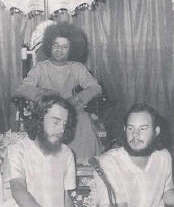
|
|
|
Tal Brooke (
right) |
Busto’s book was not the first book written by a devotee that was censored. In
the mid-sixties, Tal Brooke, a disciple of Sai Baba for three years, wrote in
his book Lord of the Air: “Suddenly a hand unzipped my fly and went
inside. My mind was reeling. If truth required these kinds of impossible
labyrinths, I had already made my vow to see it through (…) Baba’s breath turned
more rapid and agitated (…) Baba showed all the signs of desire.” Martin
Caparrós, author of ¡Dios Mío! Un viaje por la India en busca de Sai Baba
(My God!
A trip to India in Search of Sai Baba; ed. Planeta, 1994),
moved heavens and earth until he found a copy of the book, which was banned by
the government of India. He doubted Brooke’s good faith. But he transcribed his
story with the conviction that “a book that has been so persecuted deserves to
he heard.”
When
the program went on the air, the devotees screamed to high heavens. “How dare
they do a program on Sai Baba without knowing him, without having gone to
India?” Traveling to India doesn’t necessarily guarantee an interview with Baba.
The last report that he granted to the press was on March 12, 1999. It was also
the first in 25 years. The journalists from the Times of India asked him
if he had any plans to travel abroad. Baba answered: “The ants go where the
sugar is, the sugar doesn’t go in search of the ants.” In 1968 Baba traveled out
of India for the first and only time: he traveled to Uganda to visit a devotee
whom he anointed as a chosen man of God. The chosen – Idi Amín Dadá, better
known as “the African Hitler” – gave Sai Baba a gift of a Mercedes Benz loaded
with gold.
|
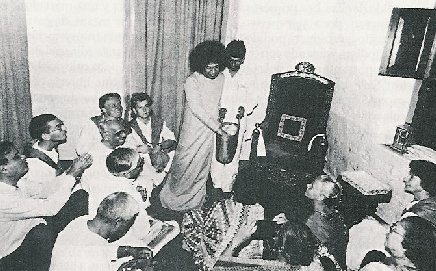 |
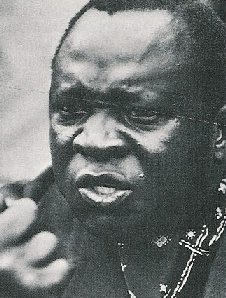 |
|
Baba's interview room. In
the background, the so called "curtain of shame" where Baba holds private
interviews with the chosen ones. |
Idi Amín Dadá gave Baba a
Mercedes Benz loaded with gold |
I was not
interested in Baba as god – or the character he portrays – but to know if there
was any evidence that he was receiving sexual favors from his devotees. There
was no budget to travel to India, nor to Sweden or the United States. But
Zona presented the stories of former devotees like Conny Larsson, the Irani-American
Said Khorramshahgol, and the American Sharon Purcell. Conny paid for his own
trip to Buenos Aires and Said and Sharon were interviewed by Diego Carro, an
Argentinean producer in Los Angeles.
Ever since
January I had been exchanging half a dozen emails a day with almost twenty
former devotees in Australia, Canada, Colombia, United States, Holland, India,
England, Sweden, Venezuela…The email was the routine previous to contact by
telephone. No trip would have allowed me to get in touch with so many people; no
TV program would have allowed itself so many months of pre-production time for
75 minutes on the air. Internet made that possible and then I understood why the
former devotees dispersed around the world had to wait for Internet in order to
group themselves. On October 15, 1999 Baba said: “Swami has nothing to do with
Internet …. All who give the wrong reports of what Baba says in the interview
room should be thrown out …, only those who observe in silence are good.
Therefore, keep the silence at all times….”
Almost
everyone I interviewed had been an officer of the Organization for 20, 10 or 5
years. They all described the spiritual collapse they lived through after
confronting their sexual experiences, in contradiction to Sai Baba’s discourses
based on defense of the purity of the human values and repudiation of physical
desires: “(Baba) asked me to lower my pants. He rubbed a ‘materialized oil’ on
my genitals and began to masturbate me. He performed oral sex on me several
times” (Conny Larsson, Sweden, 31 years old at the time). “My son couldn’t
rationalize it and stopped believing. I kept thinking that he was re-channeling
his sexual and spiritual energy. I was so stupid… I left when a friend of mine
told me that Baba put his penis in his mouth and ejaculated” (Sharon Purcell, a
devotee for 32 years, United States). “(The massage with the oil) is the way he
breaks the ice…Then he began playing with my penis …, then he took my hand and
put it on the area of his genitals, he let it go and said: ‘This is God’...”
(Said Korramshahgl, Iran, 19 years old). “Baba kissed me, caressed me and made
me do oral sex. He told me it was a ‘purification’ and he gave me watches,
rings, trinkets and cash. And he asked me not to say anything to my parents
because, in that case, he would not receive them again” (Sam Young, United
States, 16 years old).
I told
Larsson that it was difficult for me to consider a 30-year-old man as being
abused. Also that it was not easy to try to understand why, after four years of
being abused, he kept on being a devotee for another sixteen. “I accepted that
relationship because I thought it was a Divine activity,.” he answered. “I don’t
put any emphasis on that, what I am saying is that I resent being deceived and
made to believe in something that was not true. I went around the world speaking
of his miracles and I was the reason why thousands of youngsters went to him.
The least I can do now is try to undo the damage.”
|
 |
|
Conny Larsson showing the
cover of an article in a newspaper referring to the sexuall abuses of the
guru |
|
His closeness to Baba had been real. Daniel Coifman, a psychologist who spent 20 years in the
Organization, rated Conny as “an exemplary devotee. Britt-Marie Anden, who in
1991 had been national president and coordinator for the Sai Organization in
Sweden, says: “In 1989 Larsson had already revealed to me that Sai Baba had
initiated him in a kind of ‘secret ceremony’ in which a relationship had been
sealed through which he would no longer have a woman for the rest of his life.”
The devotional fervor of Britt-Marie went to pieces in August 1999, when a young
Swede whom the devotees knew as the Golden Boy confided that he was being
sexually abused by Sai Baba. He was given that nickname because Baba had
showered him with so many presents that “he was beginning to look like a
Christmas tree.” “During the several interviews that he continued having with
him,” Anden continues, “Sai Baba had lost himself in sexual desires, panting out
loud and whispering ‘I’m coming, I’m coming.’ Once when Baba ordered him to kiss
his feet, he took his head in his hands and pressed it against his pelvis and
lifting his tunic, he tried to force him to take his penis (Baba’s) in his
mouth. At that very moment the Golden Boy realized that this was no longer for
his sake, but for Baba’s own pleasure and refused to do it. Even more horrible
was to find out that officers of the Organization as well as adult devotees who
were close to Baba knew the scenario. They kept the secret and proclaimed it a
blessing because of their conviction that Baba is a pure Divine Incarnation and
all that he does is for one’s own benefit.” Larsson admits having been one of
the concealers: when one of the youngsters would confide his secret, he would
always stand up for Baba with the same arguments that the officers of the
Organization are wielding.
The most
frequent explanation that devotees have to offer in regard to the rubbing of
genitals is that it is a treatment to “balance the energy of the kundalini.”
Rick Raines, president of the South Central Region of the Sathya Sai
Organization in the United States until January 2000, left the Organization when
a friend told him that his son had been sexually abused by Baba on several
occasions. “But in reality,” he clarifies, “it was an addition to the fact that
my stepson had also received the “oil treatment” in 1989. I had heard similar
stories between 1996 and 1998. I stopped rationalizing it when I heard about
Baba’s gratification. And, if it is a ritual ¿why is it never performed on
women?” According to Raines, the sequence is as follows: “the oil treatment (at
the beginning), gifts (money, jewels, clothes), to compliments, threats (‘I’ll
never speak to your family again if you don’t do it’), false flattery to the
parents (‘he has a spiritual mission in life’), and the lies (‘next time I will
turn myself into a woman for you’), false materializations also included.”
 |
|
Leonard Gutter -
Chairman
Zone 2 Latin America |
|
The officers of the Sai Organization in Argentina hesitated about being on the
program. The writer and devotee Fernando Sanchez Sorondo refused to touch the
subject. Leonard Gutter decided to participate when he found out that the
program was going to be done anyway. “There are sectors bothered by the presence
of these high beings who come to change humanity,” he assured us. The believers
confronted the positive experiences of millions of devotees with the handful of
disappointed ones: “The more intense the light, the greater the darkness. My
best testimony is my own transformation” (Marcelo Berenstein, president of the
Sai Organization in South America). “Baba says that in Jesus’ time there was one
Judas, but now there are thousands of Judases capable of treason for a few
coins” (Jorge Hadad, president of the Sai Organization in Argentina). Monica
Socolowicz expresses the relativism of the accusations this way: “What is the
moral in the interdimension? Are we talking about a Judeo-Christian moral or a
Muslim, Mohammedan moral…? What kind of moral are we talking about?” They all
compare the situation with the crucifixion of Jesus. “Baba said this would
happen,” they concur. The prophecy came about: what they had accepted by faith
had become a reality, reevaluating the message and the meaning of the mission.
Baba referred
several times to the controversy. “Never speak in such a manner that you hurt
others,” he pontificated. “Don’t see the bad, see the good, only this way will
your eyes obtain the sacred power that will allow you to have the vision of the
Divine Cosmic Form.” Then again he seemed to have lost his patience: “These
campaigns will not affect in any way My reputation. My purity is the foundation
of the glory of My name…This propaganda comes from frustration born from envy…
Do what is good, if you can, if not keep silent… If men with their hearts
poisoned by envy send from afar all kinds of defamations, that behavior could
only be considered demoniacal and not worthy of a human being.” A more pious god
would have saved some adjectives.
Monica
Socolowicz and Daniel Coifman – who, with Gutter, integrated the founding group
– spoke with less inhibition about the subject of sexuality that surrounds Baba.
It so happens that last year another avatar was discovered in Argentina, Ricardo
Ocampo, Ananda Baba, from the Rioja region. Ocampo is 27 years old and lives in
Catamarca. He also materializes vibhuti, necklaces and lingams. He has the same
spiritual loquacity as Sai Baba. Fascinated by the new guru, Socolowicz and
Coifman distanced themselves from the Organization, especially since Baba said
that Ocampo was “a good simulator” and Gutter asked for the resignation of those
who “had one foot on two boats.”
Monica told
me that she saw Sai Baba “a thousand times” rubbing oil on the genitals of young
men. “He does an exercise on them that has to do with the acceleration of the
first chakra through the penis, but this is my own explanation, because I never
asked him.” He doesn’t do the same with women because “they don’t need any kind
of stimulation.” And she added that her own husband, Daniel Zalzman, had that
treatment. Later on, however, Zalzman denied this and told me that Baba had
never done that to him. He said he knew about the dirty gossip and appeased his
doubts, based on our miscomprehensions of God’s ways.
The
first broadcast of Zona caused a lot of commotion: whether the charges of
fraud and pedophilia were believed or not, humanizing Sai Baba and revealing
verbally the presence of occult rituals by his own devotees was enough to start
a scandal.
For Gutter,
these denouncements are an accumulation of plots, misunderstandings and
irresponsibility. The businessman made a commitment to present “indubitable
proof” of how Baba not only materialized vibhuti but also money, watches or
necklaces emerging “directly from the palm of his hand” besides other miracles,
and he generously lent the program four videos filmed by the Organization
itself. Those wonders never showed up on the tapes. Much to the contrary, Lucas
Castagna, one of the editors of the program, detected that in one scene where
Baba is surrounded by devotees, the camera registers (frame by frame) how the
avatar 1) is holding a little white pellet in his hand between the thumb and the
index finger, 2) feels for it with the thumb in order to hold it, 3) begins to
make circles in the air with his hand to camouflage the moment that he will
dissolve it, and 4) materializes the vibhuti, pressing the thumb against the
index finger, the only two fingers that show a trace of ash.
The image of
the little ball of vibhuti in between Baba’s fingers was an overwhelming proof
of fraud. For Gutter, it was “there’s nothing there to see.” Others, who were
given the choice between the TV show and Sai Baba, opted for God. After the
broadcast, it was prohibited to talk about it in the Sai centers.
It is very
difficult to evaluate how the believers were influenced by these revelations:
the impact depends on the degree of commitment. “All that carrying on,” said my
anonymous friend who is an officer in the Organization, “renewed my vows of
faith.” In a collective email addressed to all devotees, Gutter wrote: “Why did
all this happen? Maybe because of what Sai teaches us: ‘Rocks are put on the
river to give the water more speed.’”
On
September 15, 2000 UNESCO withdrew its sponsorship of a conference organized by
the Sathya Sai Organization “deeply concerned about widely-reported allegations
of sexual abuse involving youths and children that have been levelled at the
leader of the movement in question, Sathya Sai Baba” and restated “its firm
moral and practical commitment to combating the sexual exploitation of children,
in application of the United Nations Convention on the Rights of the Child,
which requires States to protect children from all forms of sexual exploitation
and violence.” If this declaration is part of a conspiracy schemed by resentful
deserters, the object of the calumnies – Sri Sathya Sai Baba – should sue his
detractors, including UNESCO. But the guru prefers to call the dissidents
Judases and invite his followers to answer with indifference. Any other attitude
would imply opening the doors of the ashram to allow for an investigation.
His major
representatives, however, did not feel called to silence. Leonard Gutter
appeared on all the TV channels in Buenos Aires to defend the incarnation of
divinity’s prestige. On October 19, two months following the broadcast, the
highest authority in the Western world of the Sai Organization, Dr. Michael
Goldstein, arrived in Buenos Aires. A graduate of George Washington University
Medical School, Goldstein is the Director of Quality and Administration in two
general hospitals in California, U.S.A. He said that Baba himself had asked him
to come. In a hall lacking in air-conditioning that became a test of faith for
many a devotee, Goldstein read a letter in which Sri Athal Bihari Vajpayee,
Prime Minister of India, manifested being hurt by “the wild, reckless and
concocted accusations made by certain vested interests and people against
Bhagavan Sri Sathya Sai Baba ... [who] is revered globally as an embodiment of
love and selfless service to humanity.” Goldstein refused to give copies of the
letter to the press. “We are still waiting for it to be subscribed by
dignitaries of the whole world,” he said. They were to get signatures from the
President of El Salvador and Guatemala, as well as Al Gore, former
vice-president of the United States. He also gave some news that left the
sweating audience mute: On September 11, the devotees that worked at the Twin
Towers and the Pentagon didn’t go to work that day or were late getting to their
jobs. “Thanks to our beloved Bhagavan,” pontificated Goldstein, “all the New
York and Washington devotees are safe.” Regardless of the fact that the Baba
sauna was making me perspire, I shuddered to think that the public might applaud
the news. But nobody did. Baba’s divine powers only benefit those faithful to
him, or was this news passed on to avoid more desertions? According to Gutter,
Baba’s love encompasses all: “There were 50,000 people working at the Towers and
only 3,000 died; then Baba saved 47,000, not only devotees. Each person has his
own karma: that was the destiny of those who died there.”
Since 1981
Goldstein has been receiving complaints from former devotees whose children were
abused sexually by their spiritual guide. I telephoned him to ask him how he
reacted to these accusations. His answer exempts me from going any further with
this article. He went to ask Baba: “He told me very clearly that He is purity
itself.” So be it.
|
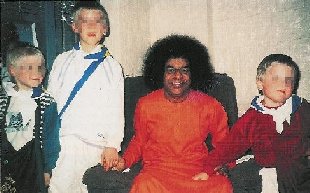
Above: Sai Baba surrounded by a group of Swedish children who
are his followers with their parents' consent. |
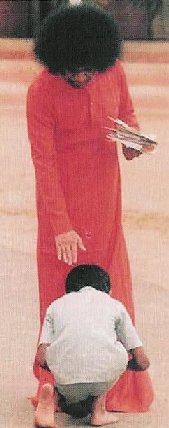 |
|
Right: The 76 year old avatar allows
one of his
young students to perform the traditional Padamascar or kissing
of the feet. |
|

Alejandro Agostinelli |
Before discovering Sai
Baba and all the material published in this edition of Gatopardo,
Agostinelli succumbed to the magic of the UFO's and other phenomena.
Towards the end of the 80's the magazine Conozca Más offered to turn him
into "the Fabio Zerpa of the 21st century", but, instead, he turned into a
skeptic and became co-founder of the first center to refute pseudosciences.
In 1995, while he tracked Hezbola in the Eastern City and covered the war
between Ecuador and Peru, he didn’t neglect for even a week "En Trance",
the first skeptical section on esotericism published in an Argentinean
newspaper (La Prensa) He was a TV producer (America TV) and editing
secretary for Descubrir magazine. Presently he is in the Multimedia
Area of Editorial Perfil in Buenos Aires, Argentina. |


 he says, “you can never
understand the Avatar.” He talks pretty, that Sai. Everything he says –
variations on the themes of love, truth and non-violence – seems to go well with
what one would expect from whom he claims to be. Besides, he materializes
brand-name watches, Tiffany jewels that have a serial number, and an abundant
amount of vibhuti – a kind of ash with reputed healing powers that seems to fall
from his fingers – to alleviate all illnesses from the multitudes of those
enamored of His Divine Presence. He can also raise the dying from their litters.
He makes invalids walk. He heals incurable diseases. From the devotees that have
nothing, he asks for nothing, except their unconditional love. One of his
faculties consists in convincing millionaire devotees to yield part of their
fortunes for acts of charity, like the upkeep of his temples in the south of
India (Puttaparthi in the state of Andhra Pradesh, and Whitefield in Karnataka),
the building of schools that teach his word or of free hospitals with the
avatar’s franchise and waterways to supply the thirstiest needy in that part of
India.
he says, “you can never
understand the Avatar.” He talks pretty, that Sai. Everything he says –
variations on the themes of love, truth and non-violence – seems to go well with
what one would expect from whom he claims to be. Besides, he materializes
brand-name watches, Tiffany jewels that have a serial number, and an abundant
amount of vibhuti – a kind of ash with reputed healing powers that seems to fall
from his fingers – to alleviate all illnesses from the multitudes of those
enamored of His Divine Presence. He can also raise the dying from their litters.
He makes invalids walk. He heals incurable diseases. From the devotees that have
nothing, he asks for nothing, except their unconditional love. One of his
faculties consists in convincing millionaire devotees to yield part of their
fortunes for acts of charity, like the upkeep of his temples in the south of
India (Puttaparthi in the state of Andhra Pradesh, and Whitefield in Karnataka),
the building of schools that teach his word or of free hospitals with the
avatar’s franchise and waterways to supply the thirstiest needy in that part of
India.






